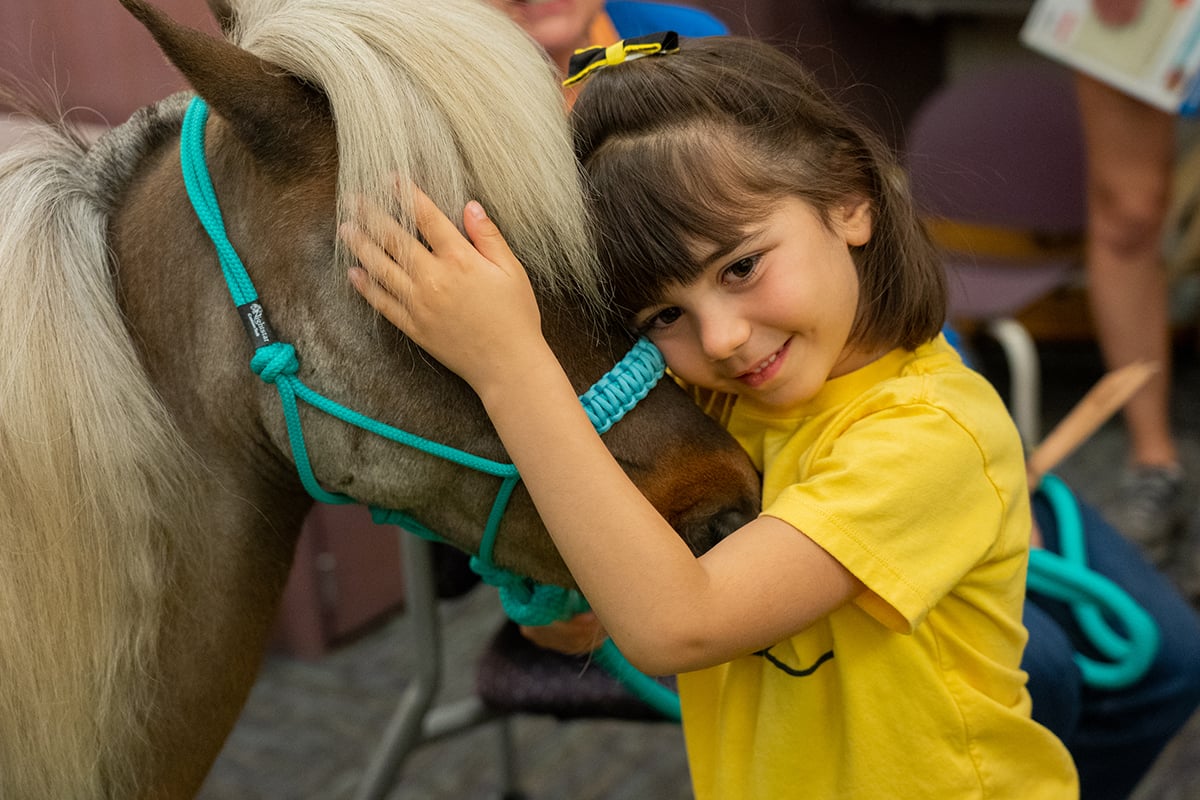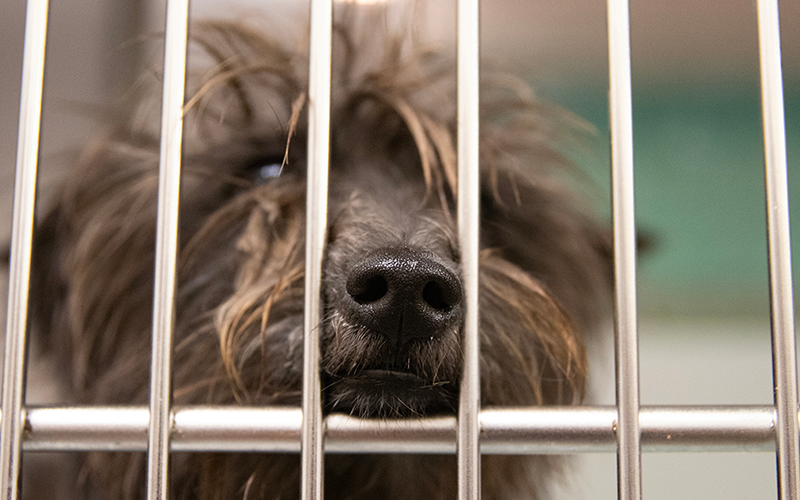
Dogs peek through their kennels at Maricopa County Animal Care and Control west shelter in Phoenix on Oct. 6, 2022. (Photo by Sophie Oppfelt/Cronkite News)

Dogs can spend weeks or months in kennels at Maricopa County Animal Care and Control in Phoenix. (Photo by Sophie Oppfelt/Cronkite News)
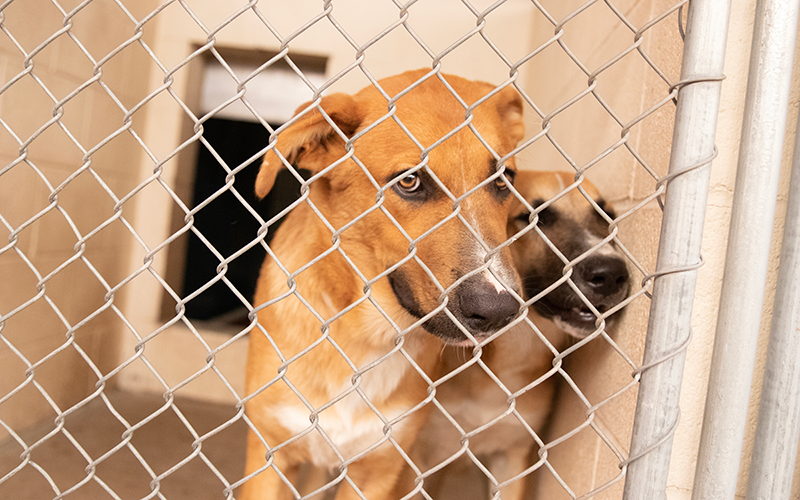
In some cases, dogs are forced to share a kennel, most often when they’re brought to the shelter together. Photo taken at Maricopa County Animal Care and Control. (Photo by Sophie Oppfelt/Cronkite News)
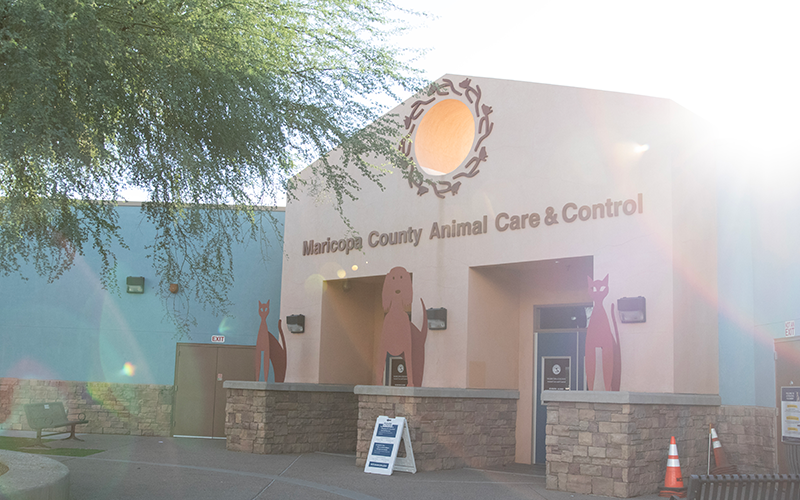
Maricopa County Animal Care and Control is home to more than 750 animals across the east and west locations. Photo taken. (Photo by Sophie Oppfelt/Cronkite News)

Terri Lineback is the founder of Animal Rights Champions of Arizona and an advocate for animals. She has been fostering animals for three years but has owned dogs almost her whole life. Photo taken in Glendale on Oct. 24, 2022. (Photo by Sophie Oppfelt/Cronkite News)
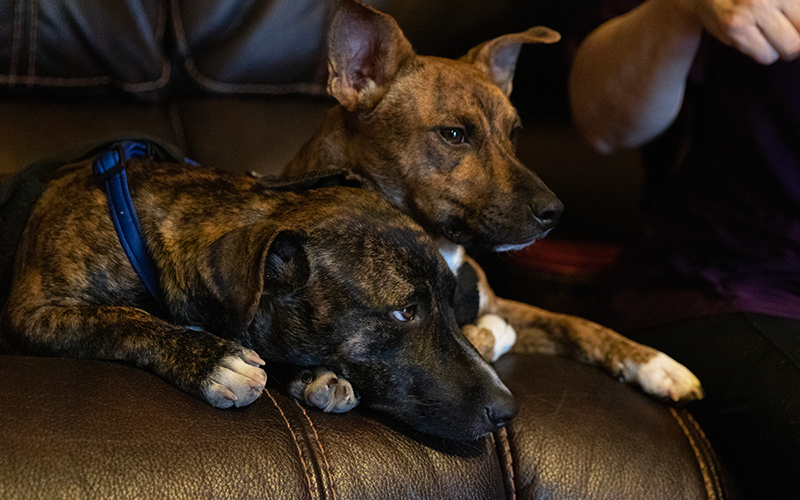
Terri Lineback is caring for two pups, Sawyer and Gunny, who were found by a busy highway in the West Valley. She’s searching for someone to permanently adopt them. Photo taken in Glendale. (Photo by Sophie Oppfelt/Cronkite News)
PHOENIX – Pets are being surrendered at an alarming rate in Maricopa County, and animal shelters and organizations across the Phoenix metro are struggling to deal with the influx.
Maricopa County Animal Care and Control and the Arizona Humane Society – two of the Valley’s largest shelters – are experiencing similar overcrowding, which seems to be attributed mainly to the rising cost of living and more owners surrendering their animals.
“One of the biggest things that we see through our admissions department is that people are surrendering their pets because of costs or they just simply can’t take care of them because they lost their job or have to decide if they’re going to pay rent this week,” said Kelsey Dickerson, media relations specialist for the the Humane Society.
The county’s east and west shelters combined have 755 kennels. As of Thursday, the shelter had 751 animals, which Kim Powell, communications officer for Maricopa County Animal Care and Control, said is at “critical capacity.”
The Arizona Humane Society had almost 200 animals up for adoption, with 1,200 more receiving treatment from the organization’s trauma hospital or in affiliated foster homes.
AHS and MCACC have incorporated staggered and appointment-only intake processes, respectively, to avoid overcrowding.
By knowing how many pets to expect that day, the Humane Society can plan accordingly to ensure adequate space and send additional pets to foster homes.
In July and August, when county-run shelters were over capacity, all departments within Animal Care and Control, including finance and IT, had to help with feeding, cleaning and caring for the animals to keep up with the numbers. In addition, the shelter had to create 50 additional kennel spaces by dividing existing kennels in half, which meant dogs had half the amount of space of an already small kennel.
Although the county recently has faced extreme capacity issues, Powell said, it’s been an ongoing problem for years, especially when the pandemic was at its peak.
“A lot of people got dogs that year (2020), which is great, but because of the shortage of veterinarians, there was a lack of spay and neutering happening, so puppies were born and their population increased even more,” Powell said.
The shelters have collaborated and begun enforcing their own solutions to mitigate the overcrowding.
The Pet Housing Help AZ task force began in 2020, once the shelters began to see some of the economic consequences of the pandemic. It’s made up of seven local animal welfare organizations: the Arizona Humane Society, Maricopa County Animal Care and Control, Altered Tails Barnhart Clinic, The Arizona Pet Project, Heidi’s Village, Lost Our Home Pet Rescue and the Arizona Animal Welfare League & SPCA.
The task force helps people looking to rehome their pets permanently or to find temporary foster homes and offers resources, such as pet rent charged by some landlords and food assistance to help keep pets out of shelters.
“As heartbreaking as it is to have to rehome your pet,” said Dickerson of the Humane Society, “some people just have to make that decision. No matter the amount of resources that they might be provided, sometimes it’s just not possible, and Pet Housing Help AZ has been huge with helping pet owners.”
Partnerships with other Valley animal welfare organizations have made a significant impact on the number of people looking to adopt at special rates, Powell said.
In partnership with Bissell Pet Foundation, Animal Care and Control hosts annual Empty the Shelter events, when adoption fees are waived. These events also offer collars, leashes and other incentives for adopting dogs and cats.
Animal Care and Control hosts other adoption events throughout the year, such as the Pupkin Patch Pup special, when adoption fees are waived for dogs who’ve been in the shelter for more than 30 days.
Powell said the shelter has started to see as many as 100 adoptions a day, which has been helping.
The Humane Society has also expanded its own foster outreach, such as for the Home Away From Home program, where homes take a pet for 30, 60 or 90 days when an owner is in crisis.
Dickerson said the society has placed about 200 pets in the program this year, which has a significant affect on pet owners and the number of animals entering the shelters.
“We bring in about 50 pets a day, and as you can imagine, those numbers really add up,” Dickerson said. “That’s why fosters, adopters and volunteers really help us, but we are definitely seeing a lot more animals come through our doors than we can place, unfortunately.”
Terri Lineback of Glendale, founder of Animals Rights Champions of Arizona, a Facebook group that supports animal shelters, has been fostering dogs for the past three years. She calls it “the first step to an animal’s new best life.”
Although she has fostered through Maricopa County shelters, she now primarily rescues and cares for lost animals she sees via Facebook posts.
Lineback has been fostering Sawyer and Gunny, feral puppies that were found along the busy West MC 85 Corridor in the Goodyear-Buckeye area.
Although these siblings don’t have a previous owner, Lineback said, her first goal in fostering generally is to find the owner and then care for the animal until it’s ready to be adopted.
“When you foster a dog, you’re doing something that’s going to impact the dog’s life for the rest of its life,” she said, “and they’re going to reward you a hundredfold for every little act of kindness that you give them – they’re so grateful.”
She said fostering is a great way to learn what’s required in caring for a pet for people who may be thinking of getting their own – without the long-term commitment – and that fostering animals prepares them to live a happy life once they arrive in their forever home.
“Fostering teaches them (the pets) what it’s like to live at home – what it sounds like when the spin cycle starts up on the washing machine, when you close the microwave, when the doorbell rings or when family comes over.”

